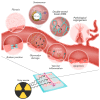Radiobiological Studies of Microvascular Damage through In Vitro Models: A Methodological Perspective
- PMID: 33803333
- PMCID: PMC7967181
- DOI: 10.3390/cancers13051182
Radiobiological Studies of Microvascular Damage through In Vitro Models: A Methodological Perspective
Abstract
Ionizing radiation (IR) is used in radiotherapy as a treatment to destroy cancer. Such treatment also affects other tissues, resulting in the so-called normal tissue complications. Endothelial cells (ECs) composing the microvasculature have essential roles in the microenvironment's homeostasis (ME). Thus, detrimental effects induced by irradiation on ECs can influence both the tumor and healthy tissue. In-vitro models can be advantageous to study these phenomena. In this systematic review, we analyzed in-vitro models of ECs subjected to IR. We highlighted the critical issues involved in the production, irradiation, and analysis of such radiobiological in-vitro models to study microvascular endothelial cells damage. For each step, we analyzed common methodologies and critical points required to obtain a reliable model. We identified the generation of a 3D environment for model production and the inclusion of heterogeneous cell populations for a reliable ME recapitulation. Additionally, we highlighted how essential information on the irradiation scheme, crucial to correlate better observed in vitro effects to the clinical scenario, are often neglected in the analyzed studies, limiting the translation of achieved results.
Keywords: in-vitro model; ionizing radiation; microenvironment; microvasculature; organ-on-chip; radiobiological models; radiotherapy.
Conflict of interest statement
The authors declare no conflict of interest.
Figures




References
-
- Rancati T., Fiorino C. Modelling Radiotherapy Side Effects. CRC Press; Boca Raton, FL, USA: 2019.
Publication types
Grants and funding
LinkOut - more resources
Full Text Sources
Other Literature Sources

